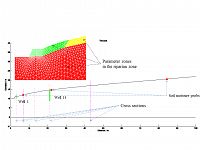FEMDOC_2D
Two-dimensional finite element model for hillslope DOC
Physically based model of water, heat, refractory DOC and biodegradable DOC transport on a 2D (vertical cross section) hillslope
Model Category: Numerical
Image: Three parameter zones were implemented in the model. Pressure transducer data from Well 3, Well 14, soil moisture data from soil moisture probes were used to calibrate the flow model. DOC flux was calculated at different cross sections as is shown in the figure.
-
Christina, GRAD STUDENT
-
Christina, INVESTIGATOR
-
Christina, INVESTIGATOR
-
Christina, INVESTIGATOR
-
Christina, INVESTIGATOR
This model is a physically based, finite element model that considers water flow and the transport of heat, and both biodegradable and refractory dissolved organic carbon (BDOC and RDOC) on hillslopes and its adjacent streams. The flow part of the model can be verified by the pressure transducer data from the wells and the stream, and soil moisture data from the installed soil moisture probes. Lab experiments were needed to separate the DOC into BDOC and RDOC to examine both of the two parts of the DOC model. Climate forcing data, soil temperature data are also needed to run the model.
Groundwater surface water interaction has significant effects on riparian zone biogeochemistry. Nitrogen can experience high biogeochemical activities occurred at the near-stream riparian zone during stage fluctuation (Gu et al., 2012) as a bank storage hot moment. DOC flux to the groundwater will increase when the water table reaches major DOC sources in the upper soil layers; this process becomes critical in riparian zone in terms of DOC export to stream [Hornberger et al., 1994]. All those processes that are highly related to the CZO work could be explored by our model.
We used this model to give a mechanistic description on the DOC delivery from a hillslopes to its adjacent streams. We also used it as a tool to explore the well-known “flushing” hypothesis of DOC export from the watershed. Thus this model can be used in the CZO projects to consider groundwater surface water interaction and nutrient and DOC dynamics.
References
Gu, C., W. P. Anderson Jr., and F. Maggi (2012), Riparian biogeochemical hot moment induced by stream fluctuations, Water Resour. Res., doi:10.1029/2011WR011720, in press.
Hornberger, G. M., K. E. Bencala, et al. (1994), Hydrological controls on dissolved organic carbon during snowmelt in the Snake River near Montezuma, Colorado, Biogeochemistry, 25(3), 147-165.
Explore Further








